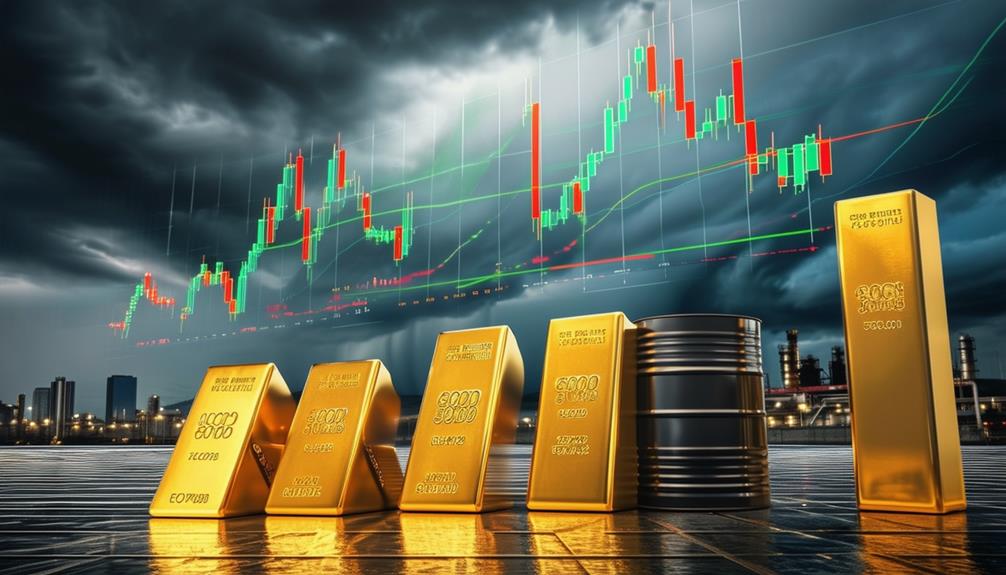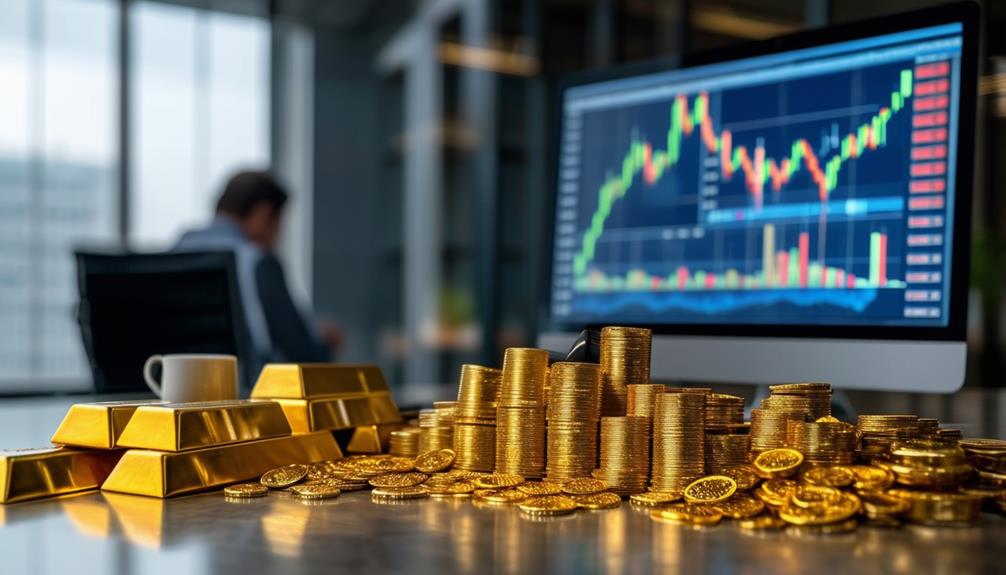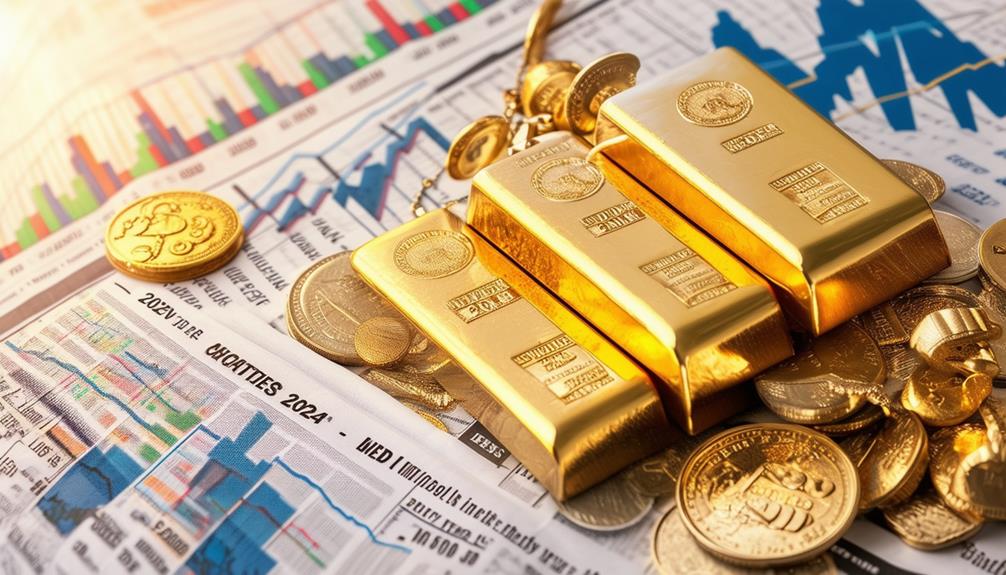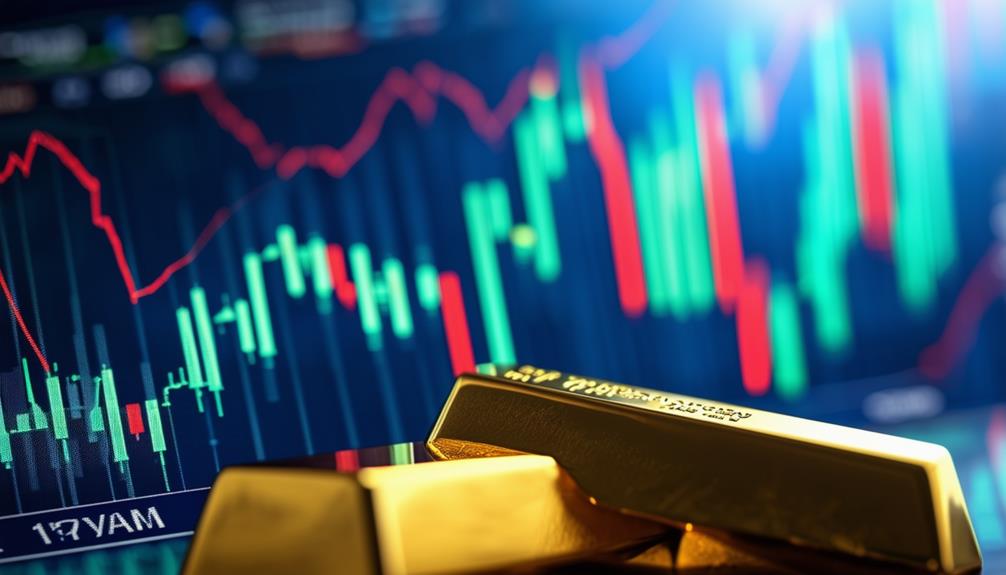The gold price outlook for 2024 depends on several key factors such as central bank policies, inflation trends, and geopolitical risks. Increased gold purchases by governments and central banks, along with rising industrial demand, are expected to exert upward pressure on prices. Conversely, potential stabilizing effects of post-election economic policies and Federal Reserve rate adjustments may moderate price increases. Investors are advised to diversify portfolios, limiting gold to no more than 10%. Understanding these dynamics is essential for steering through the gold market and optimizing investment strategies for the coming year. For a thorough exploration of these elements, continue ahead.
Gold Price Forecast for Fall 2024
As fall 2024 approaches, gold prices are projected to experience a notable rise, driven by a confluence of geopolitical turmoil and economic uncertainty. This gold price forecast reflects the collective sentiment of experts who see rising tensions and unpredictable economic conditions as key catalysts. Central banks around the world are increasing their gold purchases, viewing the precious metal as a reliable hedge against these uncertainties. This trend among central banks is expected to exert upward pressure on gold prices.
Additionally, industrial demand for gold is on the rise, further contributing to anticipated price increases. As various industries, including technology and manufacturing, continue to incorporate gold into their products, the demand for this precious metal is expected to grow. This heightened industrial demand, combined with geopolitical turmoil and economic uncertainty, creates a robust foundation for the forecasted price surge in fall 2024.
Moreover, as the US election approaches, market sentiments often pivot towards safer assets like gold, leading to potential stabilization or further increases in gold prices. To sum up, the amalgamation of central bank actions, industrial demand, and overarching geopolitical and economic factors underscores a significant upward trajectory in the gold price forecast for fall 2024.
Factors for Gold Price Increase
Increasing gold purchases by governments and central banks, amid prevailing geopolitical turmoil and economic uncertainties, stand out as primary factors driving the anticipated rise in gold prices. As nations grapple with geopolitical tensions and inflation concerns, gold is increasingly seen as a safe haven asset. Central banks are strategically boosting their gold reserves to hedge against the economic uncertainty that characterizes today’s global financial landscape.
Furthermore, the rising industrial demand for gold is another significant contributor to potential price increases. Gold’s utilization in technology and electronics sectors remains strong, ensuring a steady upward pressure on gold prices. This industrial demand, combined with the traditional investment appeal of gold, creates a dual force propelling prices upward.
Economic uncertainties, particularly those related to the impending US election and broader geopolitical risks, further amplify the attractiveness of gold. With investors seeking stability in times of change, gold’s role as a hedge becomes increasingly prominent. Essentially, the convergence of these factors—central bank purchases, geopolitical tensions, inflation concerns, and industrial demand—collectively underscores the anticipated upward trajectory of gold prices as we look toward 2024.
Factors for Gold Price Decrease

As we consider factors that could lead to a decrease in gold prices, the impact of the presidential election stands out, with a clear outcome and peaceful handover potentially stabilizing prices. Additionally, anticipated interest rate cuts by the Federal Reserve may contribute to downward pressure on gold. Together, these elements suggest a possible decline or stagnation in gold prices for 2024.
Post-Election Price Impact
The post-election landscape holds significant implications for gold prices, particularly related to potential declines. The gold price is closely linked to the political and economic environment, and the outcome of a presidential election can greatly influence market sentiment. A clear election outcome and a peaceful power shift often stabilize markets, potentially causing gold prices to settle.
Interest rates set by the Federal Reserve play a pivotal role post-election. Should the Fed decide on rate adjustments, this could lead to lower inflation expectations, impacting the price of gold. Historically, lower interest rates can diminish the appeal of gold as a non-yielding asset. Additionally, anticipated economic shifts and the potential cooling of inflation post-election can further contribute to a decrease in gold prices.
Furthermore, the gold price may be influenced by how the new administration’s policies are perceived regarding economic stability and growth. If investors anticipate a more robust economic environment, the demand for gold as a safe haven may diminish, leading to a price decrease. Understanding these interconnected factors helps investors navigate the complexities of the gold market in the post-election period.
Interest Rate Effects
Interest rates play a vital role in determining the value of gold, especially when they are set to decrease. As the Federal Reserve foresees reductions in interest rates due to cooling inflation and broader economic changes, the impact on gold prices becomes apparent. Decreasing interest rates usually make non-yielding assets like gold less enticing, potentially resulting in a drop or stabilization in gold prices.
Moreover, the expected economic stability after a clear post-presidential election result and peaceful transfer of power could lower investor demand for gold as a safe-haven asset. With inflationary pressures easing, the need to protect against inflation with gold might lessen, leading to subdued gold prices.
The Federal Reserve’s actions, particularly regarding rate cuts, play a significant role in these dynamics. As borrowing costs decline, the appeal of gold could diminish, making it less attractive compared to interest-bearing assets. These economic changes, combined with a stable political climate, indicate a possible downward trend for gold prices in 2024. For investors, grasping these interconnected factors is crucial for navigating the gold market and making well-informed decisions in line with the broader economic landscape.
Influences on Gold Price This Fall
How will the convergence of high interest rates, escalating inflation, and a looming global liquidity crisis shape the gold price this fall? The influences on the gold price this fall are multifaceted, driven by a confluence of economic factors. High interest rates often deter investment in non-yielding assets like gold; however, escalating inflation can counteract this by increasing demand for gold as a hedge against rising prices. With inflation eroding purchasing power, investors seek the stability that gold traditionally offers.
Moreover, the impending global liquidity crisis is poised to have a significant impact on the gold price. Economic factors such as increasing consumer debt levels and a potential cash crunch can create a volatile market environment. During such periods of economic uncertainty, gold is often viewed as a sanctuary asset, attracting those looking to preserve wealth amidst financial turmoil.
Tough economic times historically drive the gold price up, as the metal is seen as a valuable asset during downturns. This fall, as central banks grapple with balancing interest rates and inflation, and as global liquidity concerns heighten, the gold price is likely to be influenced by these intertwined economic dynamics.
Investment Strategies for Gold

When considering investment strategies for gold, experts suggest limiting gold to no more than 10% of an investment portfolio to effectively manage risks. As a valuable asset during economic downturns, gold plays a pivotal role in maintaining a diversified portfolio. Balancing gold investments with other assets helps optimize overall portfolio performance while mitigating the risks associated with timing gold price movements.
Diversifying With Gold
In the domain of investment strategies, diversifying with gold has long been advocated by financial experts for its risk mitigation properties. Allocating up to 10% of your investment portfolio to gold can provide a strong hedge against economic uncertainty. With governments and central banks actively purchasing gold, it’s evident that this precious metal holds significant value during economic downturns.
Gold’s role as a stable asset is essential in a long-term investment strategy. Its ability to retain value when other asset classes may falter positions it as a strategic choice for investors looking to fortify the resilience of their portfolios. While timing gold price movements can be risky, a balanced approach secures stability and growth over time.
Moreover, increased industrial demand for gold suggests potential price increases, reinforcing its appeal as a strategic asset. By diversifying with gold, investors can safeguard their wealth against geopolitical risks and economic volatility. The practice of including gold not only enhances the security of an investment portfolio but also nurtures a sense of belonging within the community of astute investors who understand the significance of safeguarding their financial future.
Balancing Investment Risks
While diversifying with gold can provide a hedge against economic instability, an effective investment strategy requires balancing the associated risks. Experts recommend limiting gold to no more than 10% of an investment portfolio. This guarantees that while investing in gold remains part of a long-term investment strategy, it does not expose the investor to undue risk. The inherent volatility in gold price movements underscores the importance of maintaining a diversified portfolio to mitigate potential losses.
Timing the market for gold can be particularly challenging and risky. Significant losses can ensue if price movements are miscalculated, emphasizing the need for diversification. To spread risk and maximize returns, investing in gold should be balanced with other investment options such as stocks, bonds, and real estate.
Understanding the factors influencing gold prices, such as geopolitical events, inflation rates, and currency fluctuations, is essential. By making informed decisions based on these factors, investors can better manage investment risks. A well-balanced approach guarantees that gold serves its purpose as a stable, value-retaining asset within a diversified portfolio, supporting a long-term investment strategy that is resilient to market uncertainties.
Expert Insights on Gold Investing
Expert opinions serve as a cornerstone for informed decision-making in gold investing. The expertise of leading thinkers provides invaluable perspectives on the dynamics of the gold market. Notable figures such as Portfolio Manager Imaru Casanova and Gold Strategist Joe Foster offer industry insights that highlight both the challenges and opportunities within this sector. These insights enable investors to identify viable investment opportunities and strategize effectively.
Investors can tap into a wealth of extensive information through various formats, including blogs, videos, webinars, and podcasts. This diverse array of resources guarantees that knowledge is accessible, catering to different learning preferences and fostering a sense of community among gold investors. For instance, the VanEck International Investors Gold Fund, which focuses on gold miners, offers exposure to this specific sector, presenting an attractive investment opportunity.
Moreover, investment vehicles like the VanEck Gold Trust allow investors to redeem shares for physical gold, providing a unique way to diversify portfolios. Additionally, ETFs such as GDX and GDXJ offer convenient access to gold mining stocks, broadening the scope for investors. Leveraging expert insights and extensive information, investors can better navigate the complexities of gold investing and make well-informed decisions.
Different Gold Investment Vehicles

Exploring the diverse landscape of gold investment vehicles requires a clear understanding of the options available to investors. Gold continues to be a cornerstone for diversified portfolios, offering various vehicles to harness its stability and potential growth.
VanEck provides multiple avenues for gold investment. One notable option is the VanEck Gold Trust, which allows investors to redeem shares for physical gold, ensuring direct exposure to the precious metal. For those seeking a diversified approach, the VanEck International Investors Gold Fund focuses on investing in gold miners, spreading risk across multiple mining entities.
Additionally, VanEck’s GDX and GDXJ ETFs offer exposure to the gold mining industry. These ETFs are tailored for investors looking to capitalize on the performance of gold mining stocks, offering both stability and potential appreciation.
To support informed decision-making, VanEck and Merk provide insights through a variety of content formats:
- Blogs
- Videos
- Webinars
- Podcasts
- In-depth reports
These resources cater to different learning preferences, ensuring that investors feel connected and well-equipped in their investment journey. By exploring these diversified gold investment vehicles, investors can find the right fit for their financial goals and risk tolerance.
Gold Price Predictions for 2024
Investors who have meticulously selected the right gold investment vehicles are now turning their attention to the gold price predictions for 2024. Analysts forecast a range between $2,421.00 and $2,651.00 per ounce, with some optimists suggesting a rise to $2,750.23 – $2,810.76. This variation in predictions reflects the inherent complexity of the gold market, influenced by factors like interest rates and inflation.
Interest rates are pivotal; lower rates typically boost gold prices as they reduce the opportunity cost of holding non-yielding assets like precious metals. Inflation, on the other hand, enhances gold’s appeal as a hedge, potentially driving its price higher. Global supply and demand changes, geopolitical tensions, and currency devaluations further complicate the forecast.
Renowned institutions like the World Bank, IMF, and Goldman Sachs provide diverse projections, ranging from $1,775.00 to $2,133.00 per ounce, indicating both conservative and bullish outlooks. This spectrum suggests that while some expect moderate stability, others foresee significant gains.
Ultimately, gold’s price outlook for 2024 is closely tied to economic and political events, as well as global uncertainties. As investors seek belonging within the gold market, staying abreast of these dynamics is essential for informed decision-making.
Technical Analysis for Gold Price

Technical analysis for gold price, a crucial tool for traders and investors, leverages various indicators such as the Relative Strength Index (RSI), Moving Average Convergence Divergence (MACD), Money Flow Index (MFI), and Moving Average (MA) Cross. These technical indicators are instrumental in deciphering prices, identifying support levels, and predicting potential trends in the gold market.
Using candlestick patterns and margin zones methodology, analysts offer trading strategies that can pinpoint specific price ranges and key support levels. This detailed technical analysis aids in making precise trading decisions, thereby enhancing the accuracy of price forecasts.
- Relative Strength Index (RSI): Evaluates overbought or oversold conditions.
- Moving Average Convergence Divergence (MACD): Indicates momentum and potential trend reversals.
- Money Flow Index (MFI): Combines price and volume data to identify market sentiment.
- Moving Average (MA) Cross: Signals potential entry or exit points based on crossovers.
- Candlestick Patterns: Offer visual cues for market sentiment analysis and price direction.
Integrating these technical indicators with market sentiment analysis allows for a more detailed understanding of buyers’ and sellers’ moods, facilitating more accurate forecasts. By analyzing these elements meticulously, traders can gain a sense of belonging in the intricate world of gold trading, empowered to make informed decisions.

